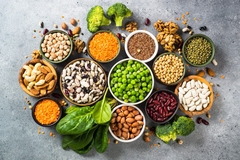
- Industry news
Industry news
- Category news
Category news
- Reports
- Key trends
- Multimedia
- Journal
- Events
- Suppliers
- Home
- Industry news
Industry news
- Category news
Category news
- Reports
- Key trends
- Multimedia
- Events
- Suppliers
Food Prices Fall Sharply in September on Economic Slowdown

FAO's monthly Food Price Index, fell 2 percent in September compared to August, to 225 points, mostly on lower international prices of grains, sugar and oils. The Index is now 13 points below the peak of 238 reached in February 2011, but still higher than its September 2010 value of 195 points.

Oct 7 2011 --- Despite improved production prospects, world cereal markets are likely to remain fairly tight in 2011/2012, the UN's FAO agency has reported.
FAO's quarterly Crop Prospects and Food Situation (CPFS) report has forecast world cereal production will total 2 310 million tonnes this marketing season, 3 percent or 68 million tonnes higher than in 2010/11. This was 3 million tonnes more than FAO forecast last month, largely because of improved expectations for wheat and rice crops.
The overall year-on-year increase includes a 4.6 percent (30 million tonnes) rise in global wheat production, a 3 percent (14 million tonnes) rise in the rice harvest and a 2.1 percent (24 million tonnes) hike for coarse grains.
Total cereal utilization in 2011/12 is also forecast to increase slightly at 2 302 million tonnes, 1.3 percent up from 2010/11.
But despite the expected production gains, the report warns that because of the slowdown in the global economic recovery and increased risks of recession, there is uncertainty as regards the impact on world food security. Worsening economic conditions could result in higher unemployment and lower incomes for the vulnerable and needy in the developing countries.
The report said the anticipated recovery in global cereal production combined with lower than earlier anticipated demand, including for ethanol, are contributing to a decline in prices. In September, international prices of all cereals with the exception of rice fell sharply, driven by large export supplies from the Black Sea region and prospects for a weakening of demand.
FAO's monthly Food Price Index, fell 2 percent in September compared to August, to 225 points, mostly on lower international prices of grains, sugar and oils. The Index is now 13 points below the peak of 238 reached in February 2011, but still higher than its September 2010 value of 195 points.
Global cereal stocks by the close of seasons in 2012 are forecast at 494 million tonnes, 7 million tonnes up from their opening level. The increase would principally stem from a 10 million tonne build-up of world rice inventories, as wheat stocks are anticipated to grow only marginally and, in the case of coarse grains, to contract by 4 million tonnes to 161 million tonnes, the lowest level since 2007. Overall, the stock-to-use ratio for cereals is expected to remain low at around 21 percent.
After declining over the previous two years, the total cereal imports of Low-Income Food-Deficit Countries in the 2011/12 marketing year are forecast to increase by about 4 million tonnes, representing a 5 percent rise over 2010/11.
This is consistent with the situation of the stagnant cereal production of LIFDCs, excluding India, in 2011 and some anticipated stock building during the marketing year.
Reviewing the food situation at regional level, CPFS noted that the humanitarian crisis in Eastern Africa, and especially in famine-ravaged southern Somalia, continues to claim lives and decimate livestock and that the immediate outlook in drought-affected pastoralist areas remains grim as the lean season progresses. Four million people are in crisis in Somalia, with 750 000 people at risk of death in the next few months in the absence of adequate response.
However, ongoing relief interventions should start to improve the situation later in the year.
In West Africa, several areas of the Sahel have been affected by irregular rains during the 2011 cropping season. An early cessation of rains will lead to significant drop in production and increased food insecurity in these regions.
In Far East Asia, a record 2011 cereal harvest is anticipated, but severe localized monsoon floods in several countries — Bangladesh, Democratic People's Republic of Korea, India, Lao People's Democratic Republic, Pakistan, Thailand and the Philippines — may dampen the final outcome. In particular, flooding in Sindh province of Pakistan has resulted in severe devastation affecting over 8 million people, destroying some 880 000 hectares of standing crops and causing the death of large numbers of livestock.
FAO's latest estimates indicate that 32 countries around the world are in need of external assistance as a result of crop failures, conflict or insecurity, natural disasters, and high domestic food prices.
The news comes as a report in the UK reported that overall shop price inflation remained at 2.7% in September. Food inflation was unchanged at 5.0% in September . Non-food inflation fell to 1.3% in September from 1.4% in August.
Stephen Robertson, British Retail Consortium Director General, said: "The pressures on prices from world commodities, import inflation and January's VAT rise haven't gone away but they haven't worsened either.
"Shop price inflation is stable and well below the Consumer Price Index, the Government's official measure of inflation.”
"The Bank of England expects CPI to go on rising but that's due to things like utilities, petrol and insurance not shop prices. In fact some goods – clothing and electricals – continue to be cheaper than a year ago as retailers discount aggressively to produce sales and stay in business.”
"Fundamental conditions are unlikely to change much this side of Christmas but next month we'll see what effect the supermarket price war - based on straight price cuts rather than other forms of promotion – is having on food inflation."











